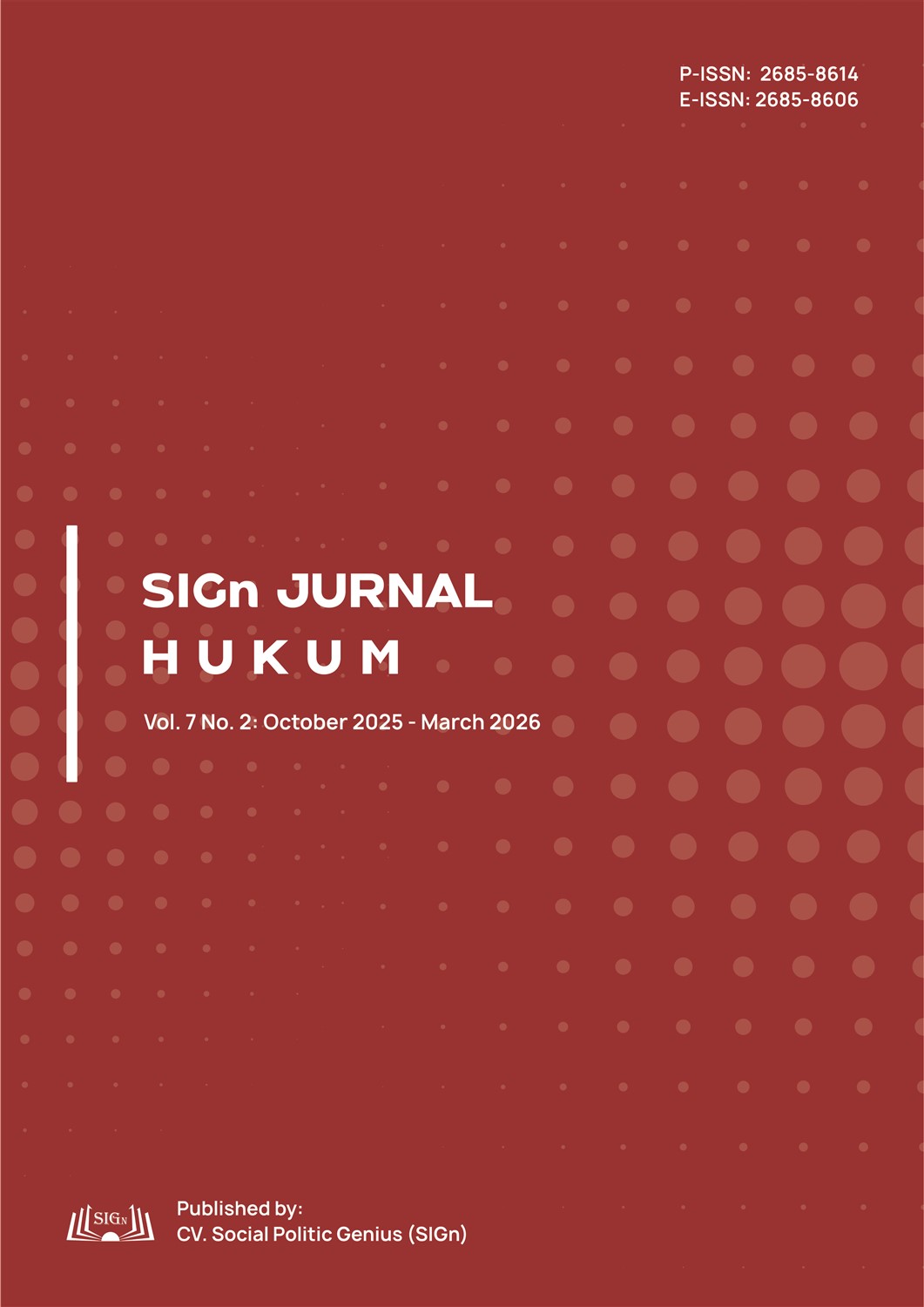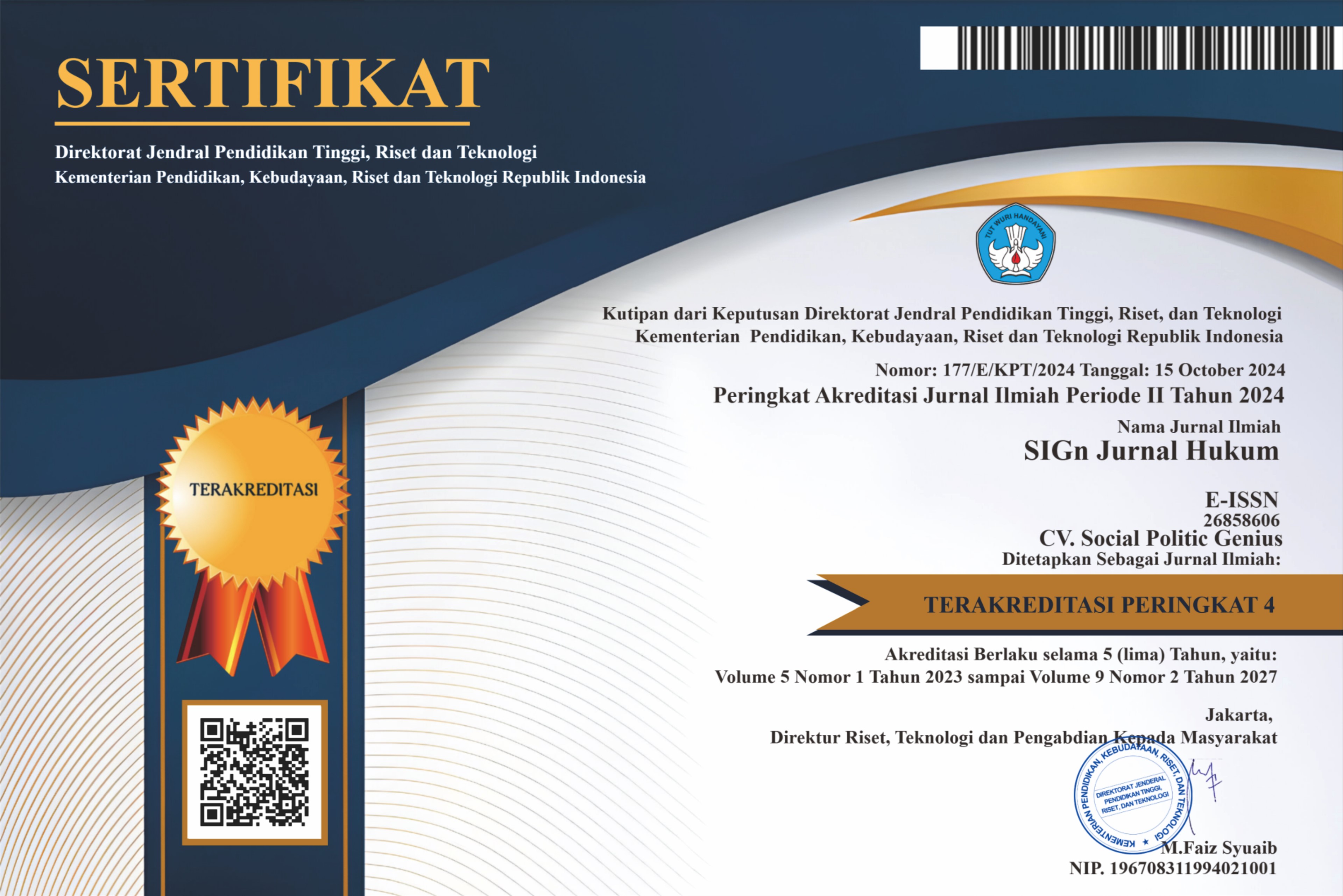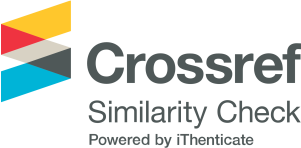Normative Reconstruction of Asset Forfeiture: A Legal Pathway Following Demise of Corruption Suspects
Abstract
The death of a corruption suspect before a final and legally binding court judgment creates a fundamental juridical paradox that paralyzes the Indonesian criminal justice system. On one hand, the state loses its instruments for recovering losses due to its reliance on the conviction-based asset forfeiture paradigm. On the other hand, seized assets are trapped in a state of uncertainty, injuring the public’s sense of justice while simultaneously threatening the civil rights of the heirs. This research aims to analyze this normative vacuum (rechtsvacuüm) critically and, as its culmination, to formulate a concrete, implementable legal reconstruction of law as it ought to be (ius constituendum). Using a normative legal research method grounded in statutory, conceptual, and critical comparative approaches, this study finds that the current juridical dead end is at odds with Radbruch’s three basic legal values: justice, certainty, and utility. As a solution, this research proposes a paradigm shift toward the NCB asset forfeiture model, operationalized through a procedural blueprint in the form of a special civil lawsuit. Based on a critical synthesis of international practices, a hybrid model is designed—termed the “Civil-Based Asset Status Examination”—which adopts the flexibility of the civil law tradition while strictly guaranteeing due process of law. The final result is a concrete normative formulation capable of reconciling the state’s interest in asset recovery with the protection of human rights, while simultaneously offering a progressive step in the renewal of criminal procedure law in Indonesia.
Downloads
References
Abdullah, F., Eddy, T., & Marlina, M. (2021). Perampasan Aset Hasil Tindak Pidana Korupsi Tanpa Pemidanaan (Non-Conviction Based Asset Forfeiture) Berdasarkan Hukum Indonesia dan United Nations Convention Against Corruption (UNCAC) 2003. Jurnal Ilmiah Advokasi, 9(1), 19-30. https://doi.org/10.36987/jiad.v9i1.2011
Aldino, M. R., & Susanti, E. (2025). The Urgency of Regulation of Non Conviction Based Asset Forfeiture in Corruption Criminal Acts in Indonesia. Jurnal Hukum Sehasen, 11(1), 97-102. https://doi.org/10.37676/jhs.v11i1.7630
Anandya, D., & Ramadhana, K. (2024, May). Report on 2023 Corruption Trends Monitoring Result. Indonesia Corruption Watch. https://icw.or.id/ZJcj
Anisa, T., & Nelson, F. M. (2024). Asset Forfeiture through Non-Conviction Based Asset Forfeiture and Management of Criminal Proceeds Assets: A Comparative Study with the United States and Thailand. Pena Justisia: Media Komunikasi dan Kajian Hukum, 23(2), 1137-1161. https://doi.org/10.31941/pj.v23i2.4183
Arief, B. N. (2018). Bunga Rampai Kebijakan Hukum Pidana. Kencana Prenada Media Group.
Asshiddiqie, J. (2006). Konstitusi dan Konstitusionalisme Indonesia. Konstitusi Press.
Behuku, J. G., Kusuma, J. I., Chasanah, N. U., Sugianto, F., & Indradewi, A. A. (2025). A The Judge’s Role in the Effectiveness of Anti-Corruption Enforcement in Indonesia: A Juridical Analysis. SIGn Jurnal Hukum, 7(1), 351-367. https://doi.org/10.37276/sjh.v7i1.464
BPHN. (2022). Naskah Akademik Rancangan Undang-Undang tentang Perampasan Aset Tindak Pidana. Kementerian Hukum dan Hak Asasi Manusia Republik Indonesia. https://bphn.go.id/data/documents/hasil_penyelarasan_na_ruu_tentang_perampasan_aset_terkait_tindak_pidana.pdf
Brunner, E., Mulyadi, M., Ekaputra, M., & Ikhsan, E. (2024). Analisis Hukum Pengembalian Kerugian Keuangan Negara Melalui Uang Pengganti dalam Putusan Pengadilan Tipikor Pada Pengadilan Negeri Medan No. 41/Pid.Sus-K/2011/PN.Mdn. Locus Journal of Academic Literature Review, 3(3), 266-282. https://doi.org/10.56128/ljoalr.v3i3.293
Cassella, S. D. (2018). Asset Forfeiture Law in the United States. In C. King et al. (Eds.), The Palgrave Handbook of Criminal and Terrorism Financing Law (pp. 427-446). Palgrave Macmillan. https://doi.org/10.1007/978-3-319-64498-1_18
Chistyakova, Y., Wall, D. S., & Bonino, S. (2021). The Back-Door Governance of Crime: Confiscating Criminal Assets in the UK. European Journal on Criminal Policy and Research, 27(4), 495-515. https://doi.org/10.1007/s10610-019-09423-5
DPR. (2024, November 19). Hasil Pencarian untuk Perampasan Aset (RUU). Dewan Perwakilan Rakyat Republik Indonesia. https://www.dpr.go.id/search?keyword=Perampasan%20Aset
Fauzi, A. M. (2018). Politik Kebijakan Pemberantasan Korupsi. Unesa University Press.
Fitriyani, D., & Maizaroh, M. (2023). The Possibility of Implementing In-Rem Asset Forfeiture as an Asset Recovery Effort in Indonesia. The Journal of Anti Money Laundering and Countering The Financing of Terrorism, 1(2), 205-219. https://doi.org/10.59593/amlcft.2023.v1i2.62
Groenhuijsen, M. S., & Kooijmans, T. (2011). Financial Investigation and Confiscation Orders in a Broader Perspective: Developments in Dutch Criminal Law. In G. Antonopoulos et al. (Eds.), Usual and Unusual Organising Criminals in Europe and Beyond: Profitable Crimes, from Underworld to Upper World (pp. 55-79). Maklu Publishers.
Hafid, I. (2021). Perampasan Aset Tanpa Pemidanaan dalam Perspektif Economic Analysis of Law. Lex Renaissance, 6(3), 465-480. https://doi.org/10.20885/jlr.vol6.iss3.art3
Handoyo, E. (2013). Pendidikan Anti Korupsi. Penerbit Ombak.
Harefa, N. S. K., Manik, G. K., Marpaung, I. K. Y., & Batubara, S. A. (2020). Dasar Pertimbangan Hakim terhadap Tindak Pidana Korupsi yang Dilakukan oleh Pegawai Negeri Sipil (PNS): Studi Kasus Putusan Pengadilan Negeri Medan Nomor: 73/Pid.Sus-TPK/2018/PN.Mdn. SIGn Jurnal Hukum, 2(1), 30-42. https://doi.org/10.37276/sjh.v2i1.68
Heathershaw, J., & Mayne, T. (2023). Explaining Suspicious Wealth: Legal Enablers, Transnational Kleptocracy, and the Failure of the UK’s Unexplained Wealth Orders. Journal of International Relations and Development, 26(2), 301-323. https://doi.org/10.1057/s41268-023-00296-0
Irwansyah. (2020). Penelitian Hukum: Pilihan Metode & Praktik Penulisan Artikel. Mirra Buana Media.
Jumantoro, T. R. P., Satya, R. M., & Rahmadani, F. N. (2025). Analisis Kerangka Regulasi Asset Forfeiture dalam Mengakhiri Praktik Impunitas Korupsi: Studi Komparasi dengan Negara Singapura, Inggris, dan Thailand. Jurnal Inspektorat, 1(1), 12-26. https://doi.org/10.64527/inspektorat.v1i1.10
Ketaren, B. R., Harahap, M., & Rehulina, R. (2024). Peranan Aparatur Penegak Hukum dalam Mencegah dan Memberantas Tindak Pidana Pencucian Uang. Judge: Jurnal Hukum, 5(1), 1-11. Retrieved from https://journal.cattleyadf.org/index.php/Judge/article/view/448
Law of the Republic of Indonesia Number 1 of 1946 on the Penal Code Regulations. https://www.dpr.go.id/dokumen/jdih/undang-undang/detail/814
Law of the Republic of Indonesia Number 8 of 1981 on the Code of Criminal Procedure (State Gazette of the Republic of Indonesia of 1981 Number 76, Supplement to the State Gazette of the Republic of Indonesia Number 3209). https://www.dpr.go.id/dokumen/jdih/undang-undang/detail/755
Law of the Republic of Indonesia Number 31 of 1999 on the Eradication of Corruption Crimes (State Gazette of the Republic of Indonesia of 1999 Number 140, Supplement to the State Gazette of the Republic of Indonesia Number 3874). https://www.dpr.go.id/dokumen/jdih/undang-undang/detail/432
Law of the Republic of Indonesia Number 20 of 2001 on Amendment to Law Number 31 of 1999 on the Eradication of Corruption Crimes (State Gazette of the Republic of Indonesia of 2001 Number 134, Supplement to the State Gazette of the Republic of Indonesia Number 4150). https://www.dpr.go.id/dokumen/jdih/undang-undang/detail/351
Law of the Republic of Indonesia Number 12 of 2005 on Ratification of the International Covenant on Civil and Political Rights (State Gazette of the Republic of Indonesia of 2005 Number 119, Supplement to the State Gazette of the Republic of Indonesia Number 4558). https://www.dpr.go.id/dokumen/jdih/undang-undang/detail/54
Law of the Republic of Indonesia Number 7 of 2006 on Ratification of the United Nations Convention against Corruption, 2003 (State Gazette of the Republic of Indonesia of 2006 Number 32, Supplement to the State Gazette of the Republic of Indonesia Number 4620). https://www.dpr.go.id/dokumen/jdih/undang-undang/detail/63
Marzuki, P. M. (2014). Penelitian Hukum. Kencana Prenada Media Group.
Muntahar, T. I., Ablisar, M., & Bariah, C. (2021). Perampasan Aset Korupsi Tanpa Pemidanaan dalam Perspektif Hak Asasi Manusia. Iuris Studia: Jurnal Kajian Hukum, 2(1), 49-63. https://doi.org/10.55357/is.v2i1.77
Pawe, T., Husen, L. O., & Muzakkir, A. K. (2025). The Paradox of a Rule of Law State: A Critical Reflection on the Dialectic between Discourse and Reality in the Eradication of Corruption in Indonesia. Sovereign: International Journal of Law, 6(1-2), 1-17. https://doi.org/10.37276/sijl.v7i1-2.56
Qamar, N., & Rezah, F. S. (2020). Metode Penelitian Hukum: Doktrinal dan Non-Doktrinal. CV. Social Politic Genius (SIGn).
Radbruch, G. (2006). Legal Philosophy (Trans. by K. Wilk). Oxford University Press.
Ramelan, R., Broto, F. A. N., Yusuf, M., Darmanto, D., Sudarsono, S., Muliana, C., Silaban, T. R., Baskoro, H., Jati, R., Ilham, M., Putuhena, F., & Zuhri, B. (2012). Laporan Akhir Naskah Akademik Rancangan Undang-Undang tentang Perampasan Aset Tindak Pidana. BPHN, Kementerian Hukum dan Hak Asasi Manusia Republik Indonesia. https://bphn.go.id/data/documents/na_ruu_tentang_perampasan_aset.pdf
Rawls, J. (1971). A Theory of Justice. Harvard University Press.
Regeling van Nederland: Wetboek van Strafvordering (Stb. 1921, 14). https://wetten.overheid.nl/BWBR0001903
Rompegading, A. M. (2022). Deterrence and Eradication of Gratification Crime. SIGn Jurnal Hukum, 3(2), 151-162. https://doi.org/10.37276/sjh.v3i2.161
Sampara, S., & Husen, L. O. (2016). Metode Penelitian Hukum. Kretakupa Print.
Sianipar, F. A., Sambas, N., & Yanto, O. (2024). The Indonesian Arrangement of Asset Forfeiture Draft as Reform Efforts in Recovering State Losses Due to Corruption: A Comparative Study of United States Code. Yuris: Journal of Court and Justice, 3(2), 29-46. https://doi.org/10.56943/jcj.v3i2.509
Soekanto, S., & Mamudji, S. (2010). Penelitian Hukum Normatif: Suatu Tinjauan Singkat. PT. Raja Grafindo Persada.
Sofian, A., Pratama, B., & Azizah, H. (2023). Mechanism for Asset Forfeiture in the Money Loundering Criminal Law and Asset Forfeiture Bill (Law Comparison with the United States). Journal of Law and Sustainable Development, 11(12), 1-33. https://doi.org/10.55908/sdgs.v11i12.1712
Sulantoro, M. A. (2021). Penerapan Prinsip Keadilan Restoratif pada Tindak Pidana Korupsi dalam Rangka Penyelamatan Keuangan Negara. Dharmasisya, 1(2), 915-926. Retrieved from https://scholarhub.ui.ac.id/dharmasisya/vol1/iss2/26
Supardi, S. (2018). Perampasan Harta Hasil Korupsi: Perspektif Hukum Pidana yang Berkeadilan. Kencana Prenada Media Group.
Syauket, A. (2025). Sita Jaminan Terhadap Harta Waris Koruptor: Pendekatan Nuansa Procedural Perdata Guna Memaksimalkan Pengembalian Aset Menuju Good Governance. Journal of Law and Security Studies, 2(1), 106-122. https://doi.org/10.31599/j72r8b58
Tantimin, T. (2023). Penyitaan Hasil Korupsi Melalui Non-Conviction Based Asset Forfeiture sebagai Upaya Pengembalian Kerugian Negara. Jurnal Pembangunan Hukum Indonesia, 5(1), 85-102. https://doi.org/10.14710/jphi.v5i1.85-102
Thai Royal Gazette: Anti-Money Laundering Act 1999 (B.E. 2542). https://www.amlo.go.th/amlo-intranet/media/k2/attachments/AMLAYconsolidatedY1-6Yfinal_4754.pdf
UK Public General Acts: Criminal Finances Act 2017 (c. 22). https://www.legislation.gov.uk/ukpga/2017/22
UK Public General Acts: Proceeds of Crime Act 2002 (c. 29). https://www.legislation.gov.uk/ukpga/2002/29
United Nations General Assembly. (1966, December 16). Resolutions Adopted on the Reports of the Third Committee: International Covenant on Economic, Social and Cultural Rights, International Covenant on Civil and Political Rights and Optional Protocol to the International Covenant on Civil and Political Rights (A/RES/2200(XXI)[A]). https://digitallibrary.un.org/record/660187
United Nations General Assembly. (2003, November 21). Resolution Adopted by the General Assembly: United Nations Convention against Corruption (A/RES/58/4). https://digitallibrary.un.org/record/505186
United States Court of Appeals for the Eighth Circuit. (2006, August 18). United States of America, Plaintiff-Appellant, v. $124,700 in United States Currency, Defendant-Appellee, and Manuel Gomez; Andres Madrigal Morgan; Emiliano Gomez Gonzolez, Claimants-Appellees (Docket Number: 05-3295. Submitted: April 19, 2006). https://openjurist.org/458/f3d/822
US 106th Congress: Civil Asset Forfeiture Reform Act of 2000 [Public Law 106-185]. https://www.govinfo.gov/app/details/PLAW-106publ185
Vieira, A., & Rodríguez, Á. (2025, April 24). Non-Conviction Based Confiscation and Unexplained Wealth Orders: A Contradiction in Terms? Fair Trials. Retrieved August 5, 2025, from https://www.fairtrials.org/articles/legal-analysis/non-conviction-based-confiscation-and-unexplained-wealth-orders-a-contradiction-in-terms
Yusuf, M. (2014). Merampas Aset Koruptor: Solusi Pemberantasan Korupsi di Indonesia. Kompas.
Zyham, Z., Marlina, A., & Suhartina, S. (2022). Asset Recovery Corruption by the Heirs. Delictum: Jurnal Hukum Pidana Islam, 1(1), 1-18. https://doi.org/10.35905/delictum.v1i2.3189
Copyright (c) 2025 Anang Suhartono, Hulman Panjaitan

This work is licensed under a Creative Commons Attribution 4.0 International License.

















